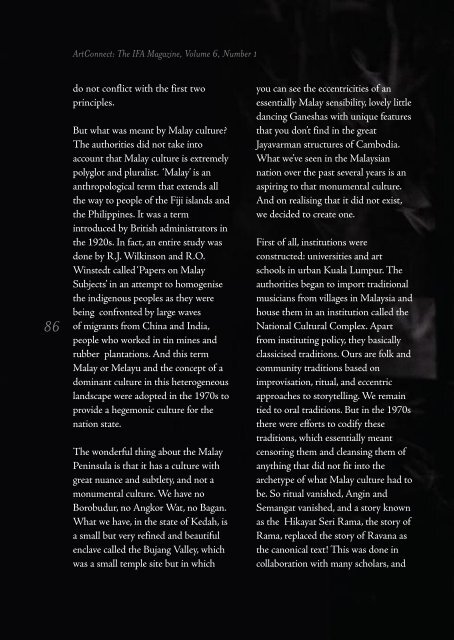Layout 3 - India Foundation for the Arts - IFA
Layout 3 - India Foundation for the Arts - IFA
Layout 3 - India Foundation for the Arts - IFA
You also want an ePaper? Increase the reach of your titles
YUMPU automatically turns print PDFs into web optimized ePapers that Google loves.
86<br />
ArtConnect: The <strong>IFA</strong> Magazine, Volume 6, Number 1<br />
do not conflict with <strong>the</strong> first two<br />
principles.<br />
But what was meant by Malay culture?<br />
The authorities did not take into<br />
account that Malay culture is extremely<br />
polyglot and pluralist. ‘Malay’ is an<br />
anthropological term that extends all<br />
<strong>the</strong> way to people of <strong>the</strong> Fiji islands and<br />
<strong>the</strong> Philippines. It was a term<br />
introduced by British administrators in<br />
<strong>the</strong> 1920s. In fact, an entire study was<br />
done by R.J. Wilkinson and R.O.<br />
Winstedt called ‘Papers on Malay<br />
Subjects’ in an attempt to homogenise<br />
<strong>the</strong> indigenous peoples as <strong>the</strong>y were<br />
being confronted by large waves<br />
of migrants from China and <strong>India</strong>,<br />
people who worked in tin mines and<br />
rubber plantations. And this term<br />
Malay or Melayu and <strong>the</strong> concept of a<br />
dominant culture in this heterogeneous<br />
landscape were adopted in <strong>the</strong> 1970s to<br />
provide a hegemonic culture <strong>for</strong> <strong>the</strong><br />
nation state.<br />
The wonderful thing about <strong>the</strong> Malay<br />
Peninsula is that it has a culture with<br />
great nuance and subtlety, and not a<br />
monumental culture. We have no<br />
Borobudur, no Angkor Wat, no Bagan.<br />
What we have, in <strong>the</strong> state of Kedah, is<br />
a small but very refined and beautiful<br />
enclave called <strong>the</strong> Bujang Valley, which<br />
was a small temple site but in which<br />
you can see <strong>the</strong> eccentricities of an<br />
essentially Malay sensibility, lovely little<br />
dancing Ganeshas with unique features<br />
that you don’t find in <strong>the</strong> great<br />
Jayavarman structures of Cambodia.<br />
What we’ve seen in <strong>the</strong> Malaysian<br />
nation over <strong>the</strong> past several years is an<br />
aspiring to that monumental culture.<br />
And on realising that it did not exist,<br />
we decided to create one.<br />
First of all, institutions were<br />
constructed: universities and art<br />
schools in urban Kuala Lumpur. The<br />
authorities began to import traditional<br />
musicians from villages in Malaysia and<br />
house <strong>the</strong>m in an institution called <strong>the</strong><br />
National Cultural Complex. Apart<br />
from instituting policy, <strong>the</strong>y basically<br />
classicised traditions. Ours are folk and<br />
community traditions based on<br />
improvisation, ritual, and eccentric<br />
approaches to storytelling. We remain<br />
tied to oral traditions. But in <strong>the</strong> 1970s<br />
<strong>the</strong>re were ef<strong>for</strong>ts to codify <strong>the</strong>se<br />
traditions, which essentially meant<br />
censoring <strong>the</strong>m and cleansing <strong>the</strong>m of<br />
anything that did not fit into <strong>the</strong><br />
archetype of what Malay culture had to<br />
be. So ritual vanished, Angin and<br />
Semangat vanished, and a story known<br />
as <strong>the</strong> Hikayat Seri Rama, <strong>the</strong> story of<br />
Rama, replaced <strong>the</strong> story of Ravana as<br />
<strong>the</strong> canonical text! This was done in<br />
collaboration with many scholars, and


